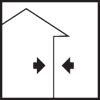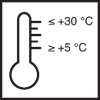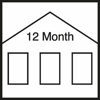Article No. 051725
Universal cementing and reinforcement mortar
Product specifications
Two layers: up to max. 6 mm
The stated values represent typical product characteristics and are not to be construed as binding product specifications.
Field of application
- Cementing and reinforcement mortar
- Repairing cracked render and bonded thermal insulation systems on facades
- Plinth render
Properties
- Repels water
- Water vapour permeable
- Good adhesive properties
- Resistant to water, frost and weathering
- Machine workable
-
Preparation
-
Substrate requirements
Clean, dust-free and capable of supporting a load.
-
Preparations
Pre-wet the substrate so that it is slightly moist.
-
-
Application
-
Contact layer
Using a suitable tool, apply the product as a contact layer.
Reinforcing layer
Using a toothed trowel, apply the material in a coating thickness of 3 mm.
Embed reinforcement fabric in the upper third of the render, with fabric widths overlapping by at least 10 cm.
Surface finishing with VM Fill
Apply the second layer while the first is still wet.
Smooth the surface using a suitable tool.
Finish the surface once set.
Surface finishing with VM Fill rapid
Using a suitable tool, apply the product to the hardened layer.
Smooth the surface using a suitable tool.
Finish the surface once set.
Cementing insulation panels
Cement using a point-bead procedure.
-
Application instructions
-
Once it has hardened, mortar must not be made workable again by adding either water or more wet mortar.
Protect wet mortar surfaces against frost, rain and drying out too quickly for at least 4 days.
Hairline/shrinkage cracks are safe and are not cause for complaint as they do not impair the properties of the mortar.
Apply additional diagonal reinforcement to the edges of building openings.
Do not interrupt work when coating continuous surfaces.
On larger surfaces and when there are several levels of scaffolding, coating should be carried out on all levels at the same time to avoid seams.
Please contact Remmers Technical Service (phone +49 5432 83900) before applying with machine processing.
-
-
Working tools / cleaning
-
Mixing tool, notched trowel, trowel, smoothing trowel, plasterer's float, sponge float
Clean tools with water while the material is still fresh.
-
Storage / shelf life
-
If stored in an unopened container and in a dry place, the product will keep for approx. 12 months.
-
Usage
-
Approx. 1.2 kg/m²/mm layer thickness
-
Apply to a large enough trial area to determine the precise amount required.
-
General information
-
Do not work on substrates where moisture is penetrating from the rear.
The colour that is obtained after drying and hardening depends on the ambient conditions and the processing method. For instance, a freshly smoothed surface will be lighter than one that is smoothed later or roughened. Different grain sizes of the same product may lead to slight differences in colour. Substrates soaked from the back may cause discolouration.
When coating continuous surfaces, only use materials with the same batch number.
Take appropriate measures to protect adjacent building elements and materials that should not come into contact with the product.
May contain traces of pyrite (iron sulphide).
Do not use on gypsum-based substrates.
The mixing water must be of drinking water quality.
Low chromate content in accordance with Directive 2003/53/EC.
Always set up a trial area/trial areas first.
Current regulations and legal requirements must be taken into account and deviations from these must be agreed separately.
The relevant test certificates must be observed when planning and carrying out work.
-
-
Disposal instructions
-
Larger quantities of leftover product should be disposed of in the original containers in accordance with the applicable regulations. Completely empty, clean containers should be recycled. Do not dispose of together with household waste. Do not allow to enter the sewage system. Do not empty into drains.
-
-
Safety / regulations
-
For further information on the safety aspects of transporting, storing and handling the product and on disposal and environmental matters, please see the current Safety Data Sheet.
-











